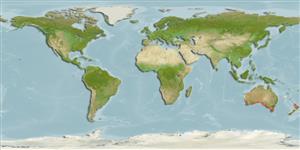>
Eupercaria/misc (Various families in series Eupercaria) >
Labridae (Wrasses)
Etymology: Pictilabrus: Latin, pictus = painted + Greek, labrax, -akos = a fish, Dicentrarchus labrax (Ref. 45335); laticlavius: Specific name alludes to the ornamental blue spots on the fins, similar to the clavi on the borders of the Roman patrician dress.
More on author: Richardson.
Environment: milieu / climate zone / depth range / distribution range
पारिस्थितिकी
समुद्री प्रवाल-भित्ति संयुक्त; गहराई सीमा ? - 40 m (Ref. 26203). Temperate
Eastern Indian Ocean: southern Australia, from southern Western Australia to New South Wales, including Tasmania.
आकार / वज़न / Age
Maturity: Lm ? range ? - ? cm
Max length : 23.0 cm SL पुल्लिंग / अलिंग; (Ref. 26203)
Inhabits rocky reef-algal habitats and occurs to as deep as 40 m (Ref. 26203).
Life cycle and mating behavior
परिपक्व अवधि | पुनरुत्पत्ति | मछलीऔ का अंडे देना | अंडे | Fecundity | लार्वा
Oviparous, distinct pairing during breeding (Ref. 205).
Russell, B.C., 1988. Revision of the labrid fish genus Pseudolabrus and allied genera. Rec. Aust. Mus. (Suppl. 9):1-72. (Ref. 26203)
IUCN Red List Status (Ref. 130435: Version 2024-1)
Threat to humans
Harmless
Human uses
साधन
Special reports
Download XML
इंटरनेट स्रोत
Estimates based on models
Preferred temperature (Ref.
123201): 14.4 - 21.9, mean 17.2 °C (based on 116 cells).
Phylogenetic diversity index (Ref.
82804): PD
50 = 0.6250 [Uniqueness, from 0.5 = low to 2.0 = high].
Bayesian length-weight: a=0.00977 (0.00470 - 0.02030), b=3.07 (2.90 - 3.24), in cm total length, based on LWR estimates for this (Sub)family-body shape (Ref.
93245).
Trophic level (Ref.
69278): 3.6 ±0.4 se; based on size and trophs of closest relatives
लौटाव (Ref.
120179): माध्यम, न्यूनतम जनसंख्या दुगनी होने का समय 1.4 - 4.4 वर्ष। (Preliminary K or Fecundity.).
Fishing Vulnerability (Ref.
59153): Low vulnerability (18 of 100).
Nutrients (Ref.
124155): Calcium = 21.3 [8.8, 38.9] mg/100g; Iron = 0.213 [0.114, 0.458] mg/100g; Protein = 18.8 [15.8, 21.0] %; Omega3 = 0.384 [0.206, 0.738] g/100g; Selenium = 5.77 [2.60, 12.91] μg/100g; VitaminA = 90.8 [22.5, 444.7] μg/100g; Zinc = 0.736 [0.475, 1.325] mg/100g (wet weight);
